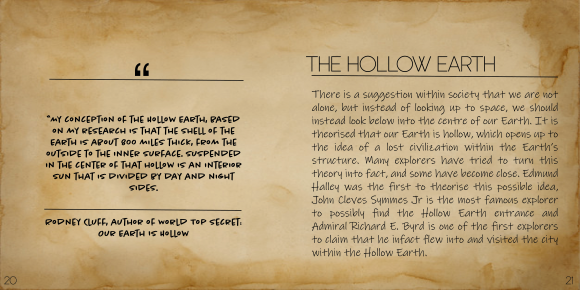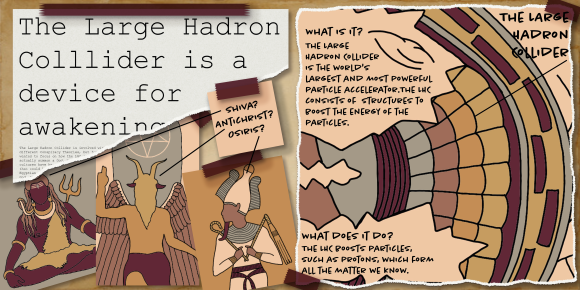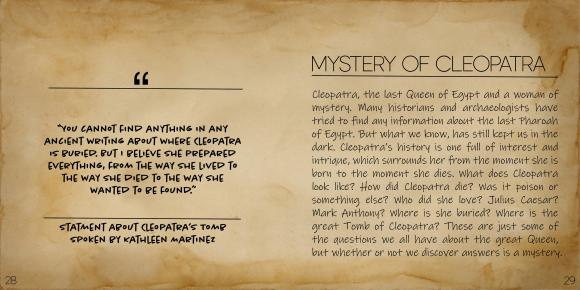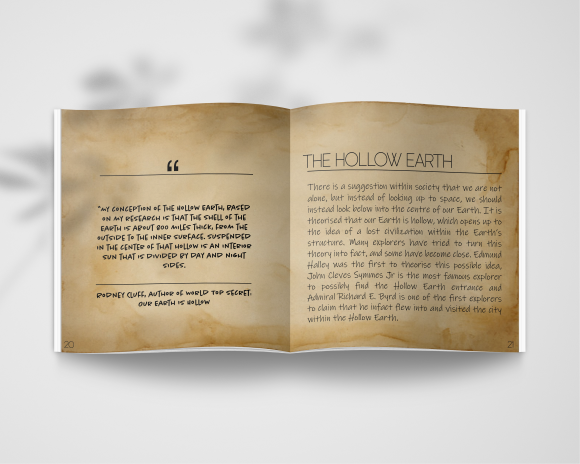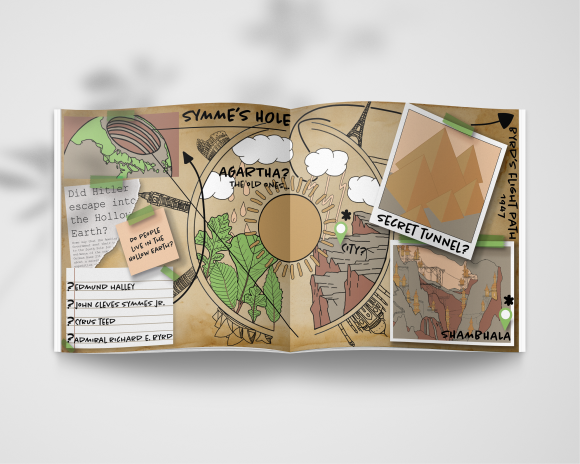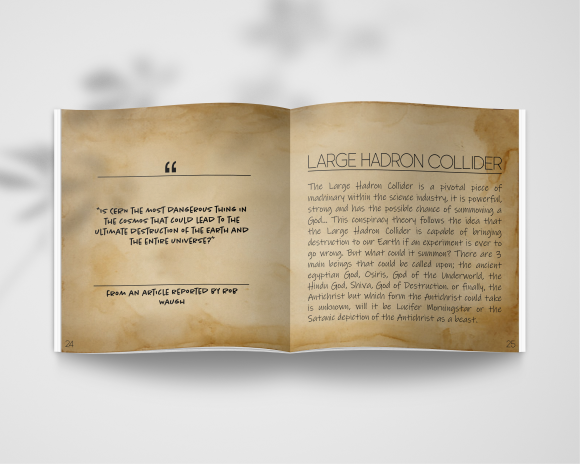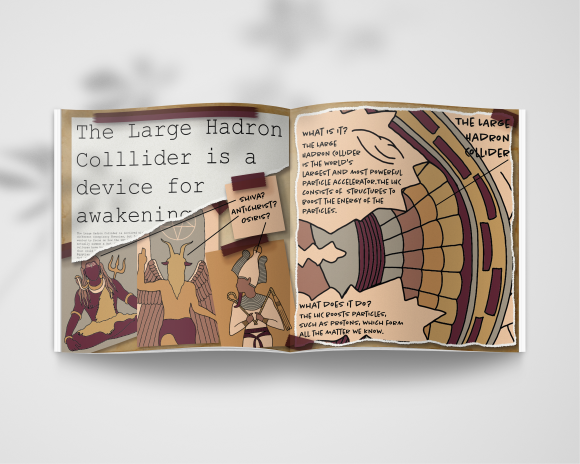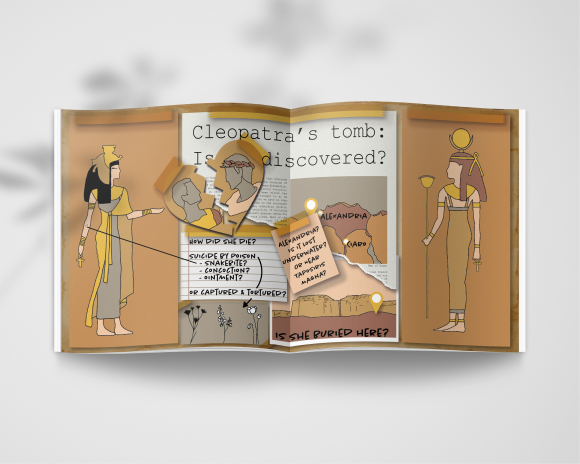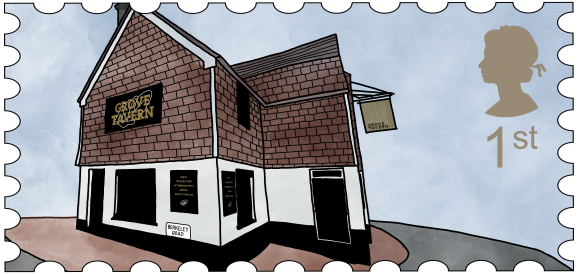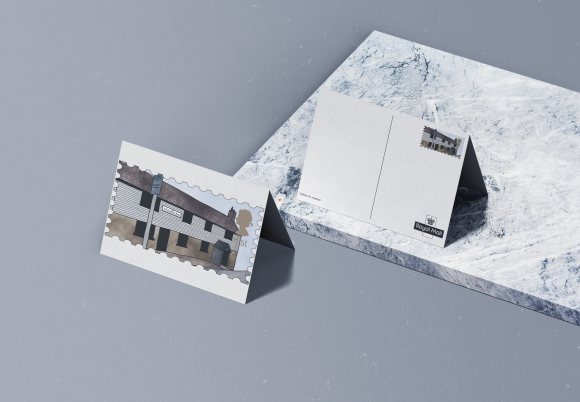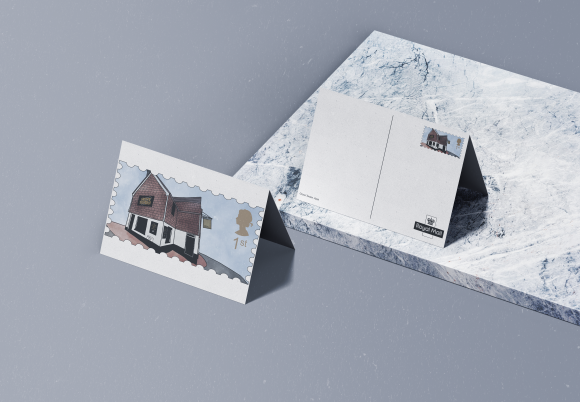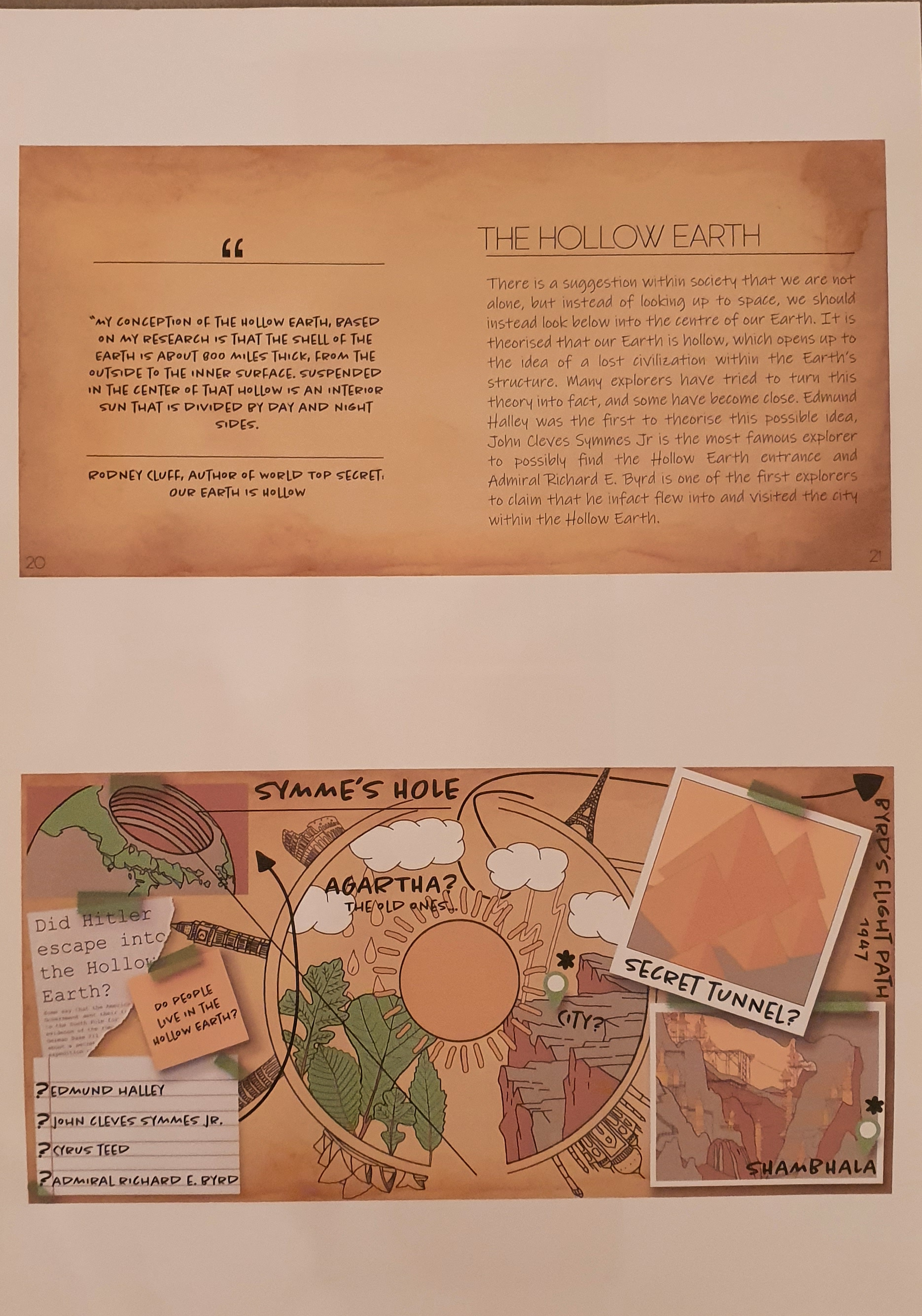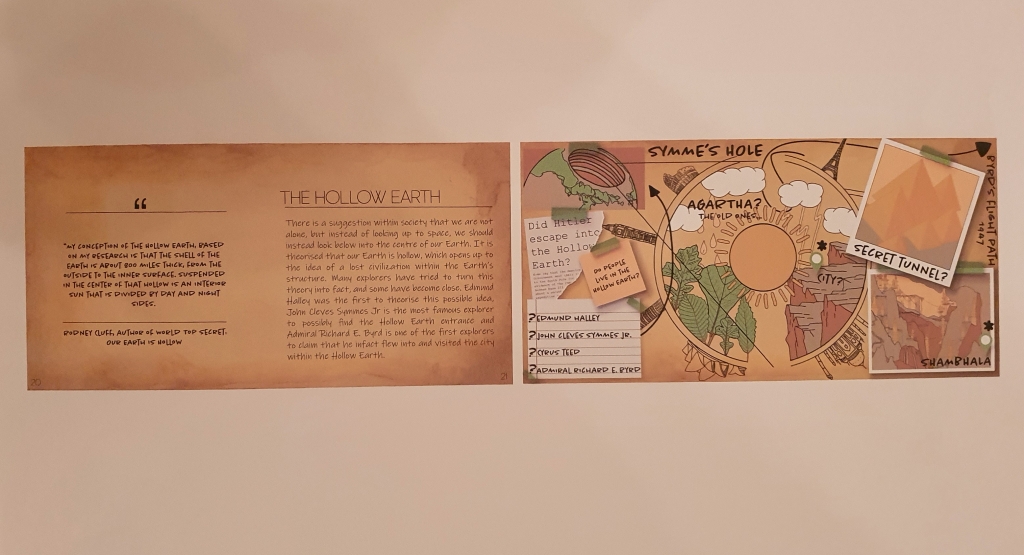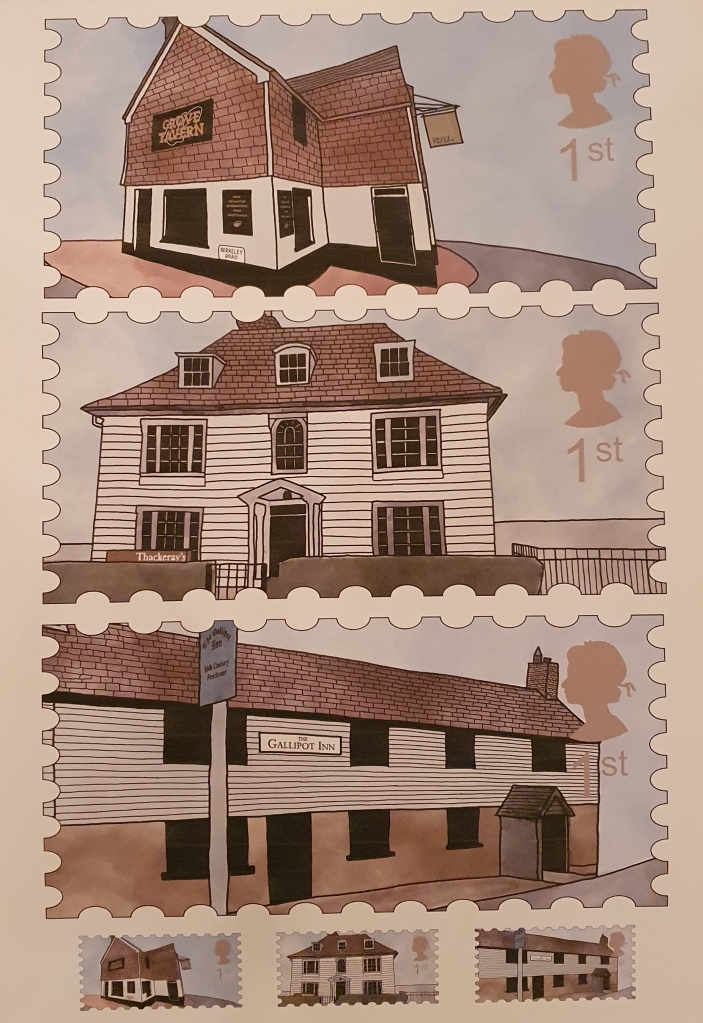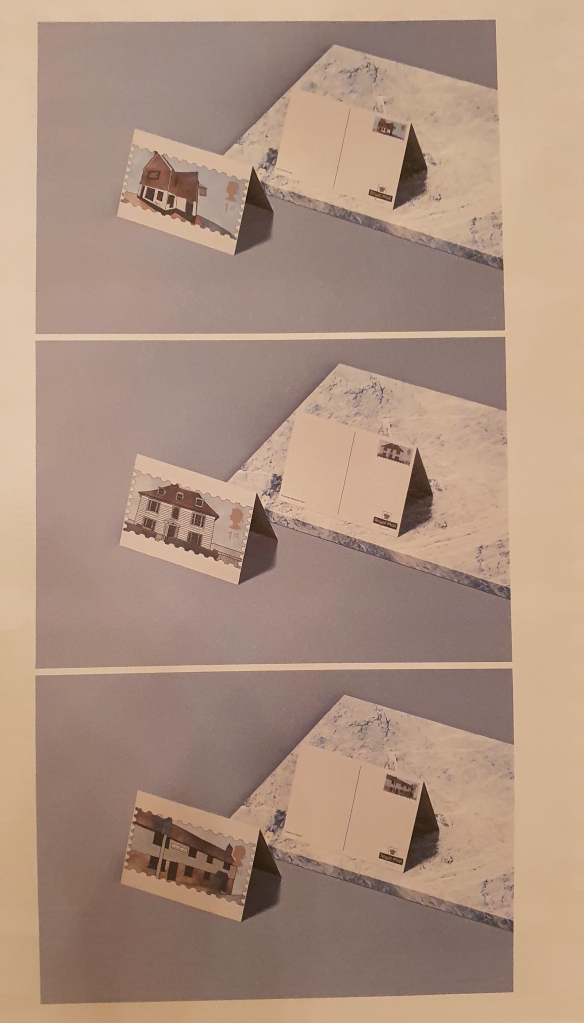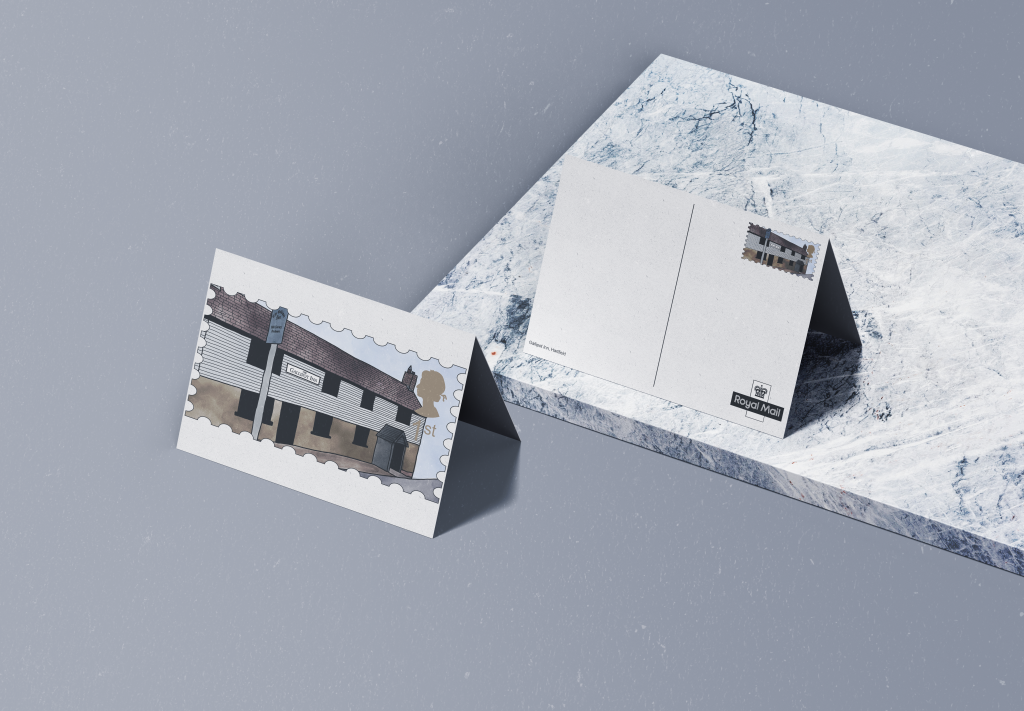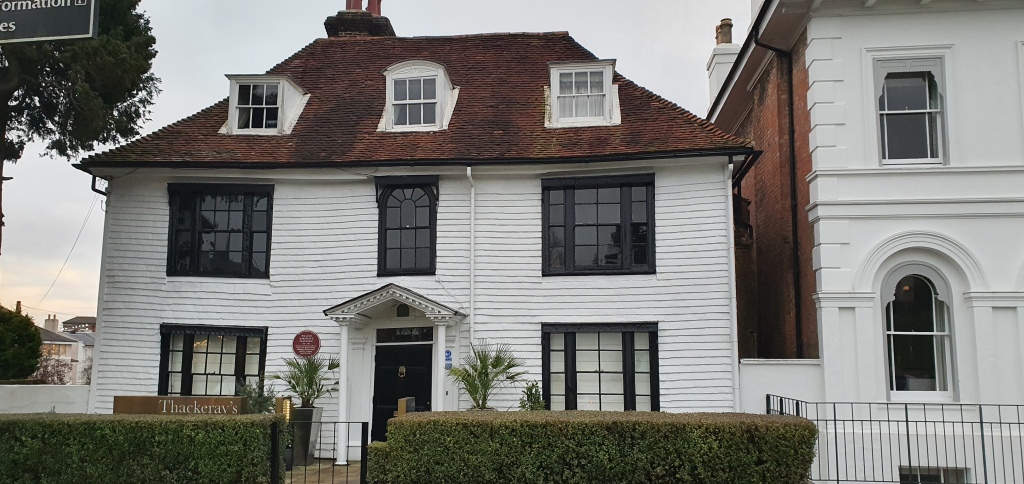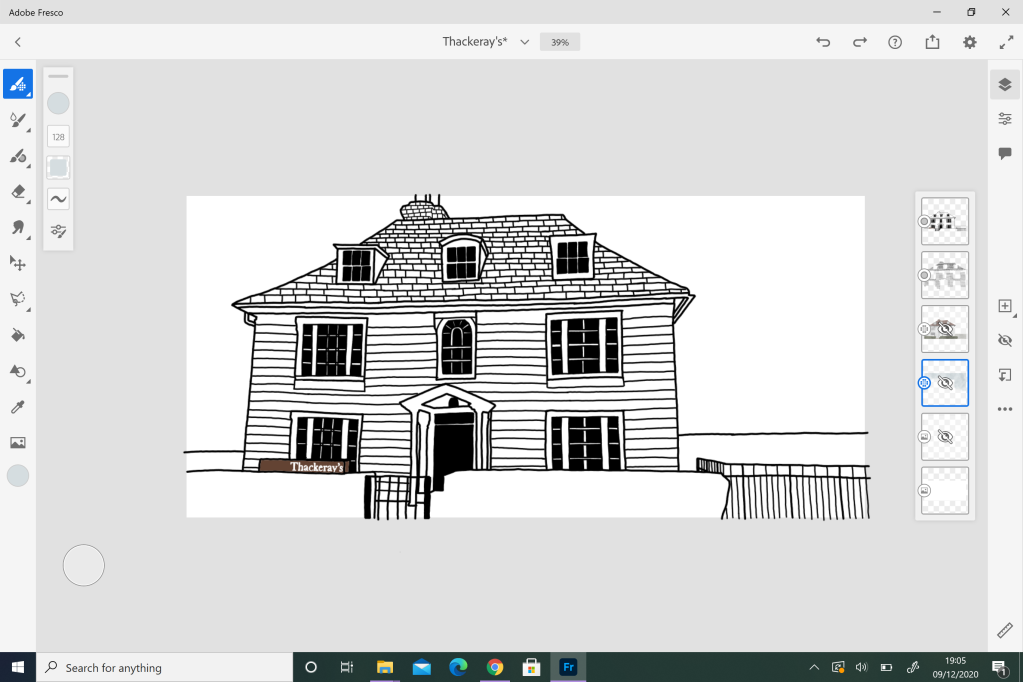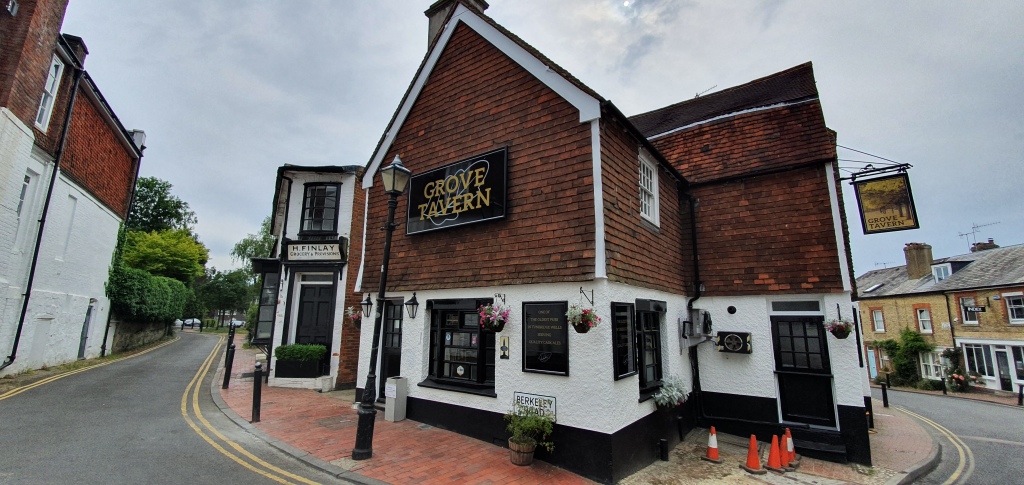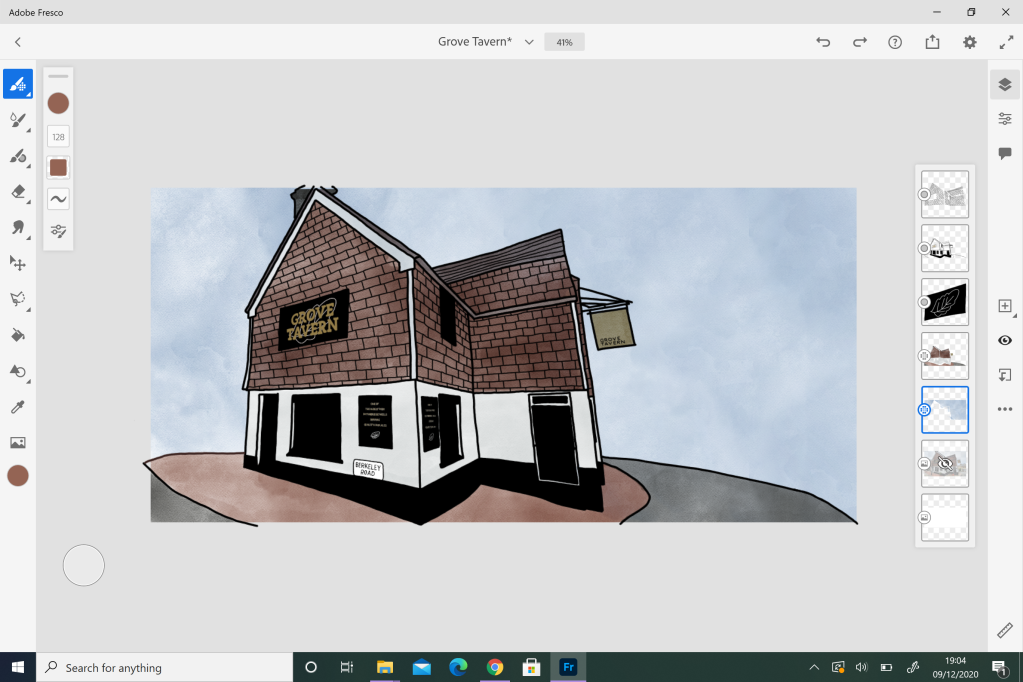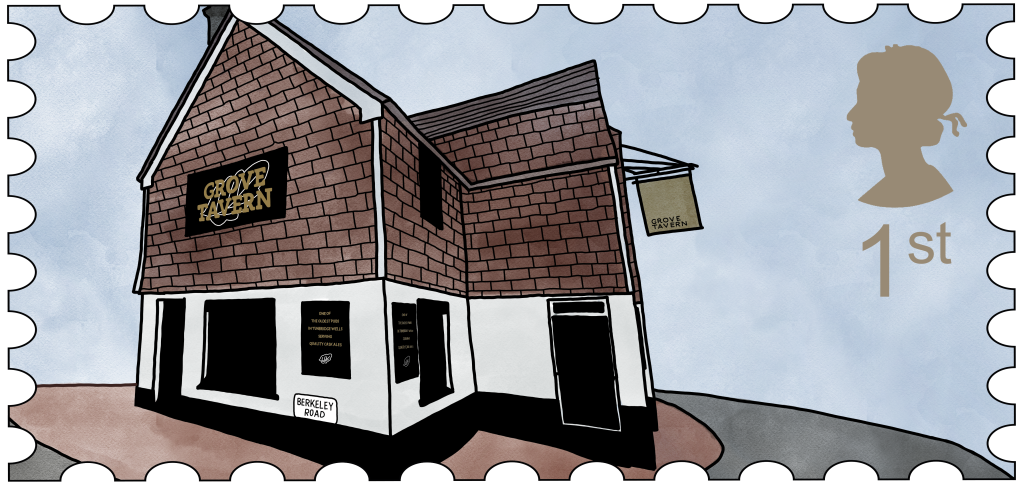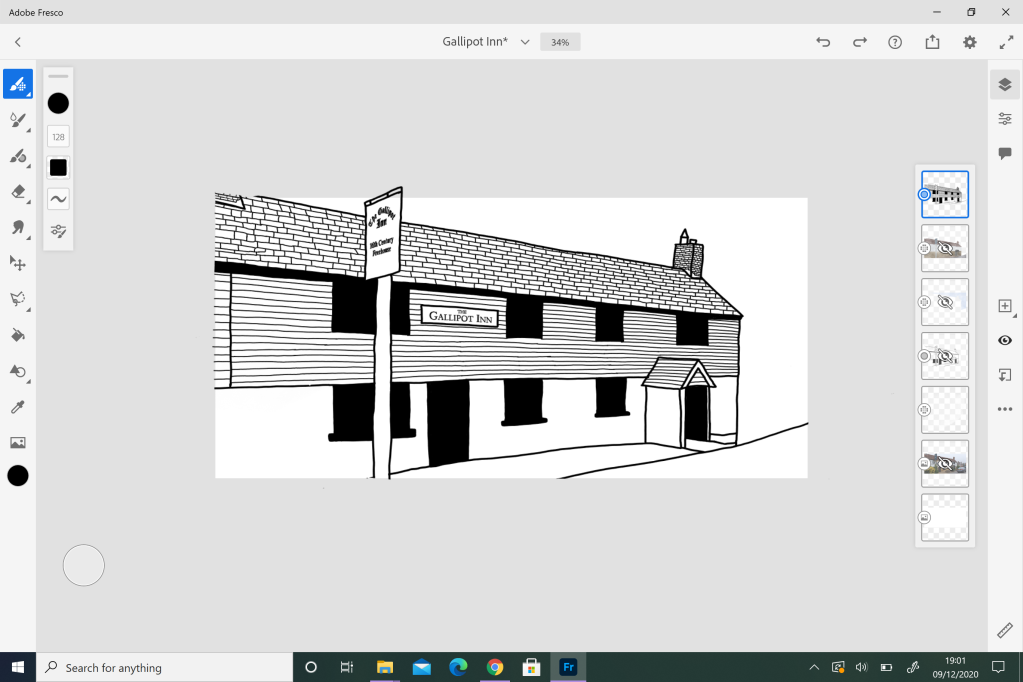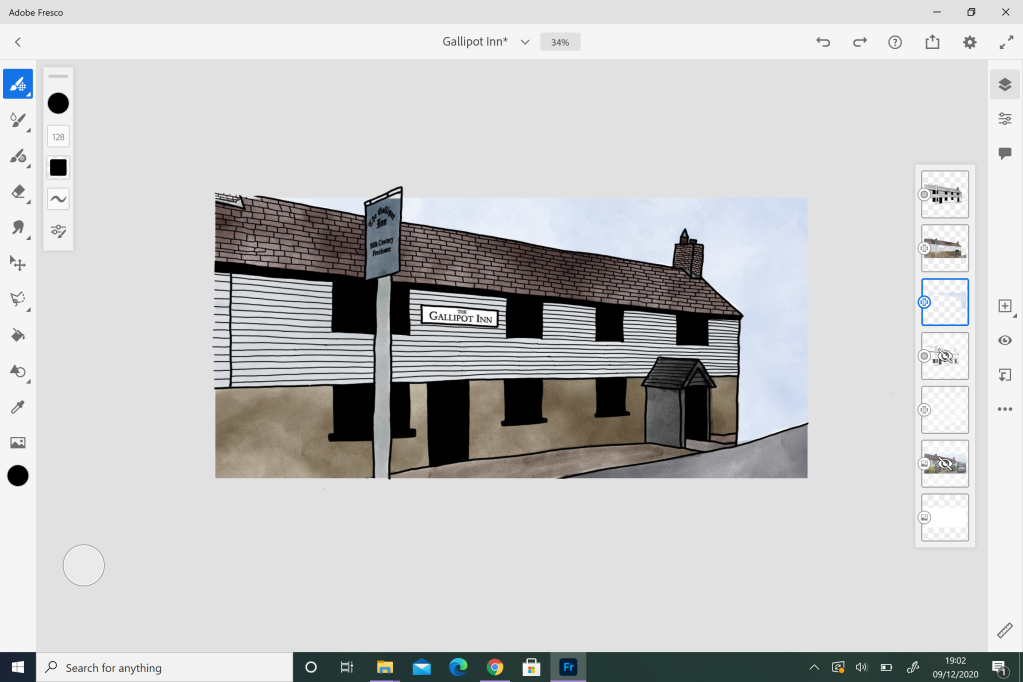We have come to the end of my project! Below I have included all of the final pieces listed within the deliverables as well as the written evaluation:
Conspiracy Theories:
Conspiracy Theory Mockups:
Commemorative Stamps:
Printing Page for the Stamps:

Commemorative Stamps Mockups:
Evaluation:
In what ways does the visual communication/message of the piece meet the needs of the brief?
Conspiracy Theory
The brief asked us to create 3 illustrations based on 3 conspiracy theories, the overally layout of these illustrations can be designed in anyway. My illustrations followed the idea of an infographic, taking inspiration from a police investigation board and I think my final pieces meet the required needs of the brief. I chose 3 different Conspiracy Theories – Hollow Earth, The Large Hadron Collider is a device for awakening a God and the Mystery of Cleopatra – as for my illustrations, I have done more than 3 on each infographic, but have classed one infographic as one illustration in terms of this project.
Commemorative Stamps
The second part of the project offered a new brief, which asked us to design 2 – 4 Commemorative Stamps, ones that specifically focus on celebrating an idea, concept, object, piece of history or anything at all that would be reasonably featured on a UK stamp. For my theme, I chose to celebrate the hospitality trade after the horrendous year we have just had with the Covid-19 pandemic, and I decided to fall in the middle of the required amount by producing 3 final stamp designs.
In what ways does the visual communication/message of the piece fail to meet the needs of the brief?
Conspiracy Theory
I personally think that my illustrations meet the required needs of the brief, and don’t fail in the ideals of a visual communication or message.
Commemorative Stamps
For the stamps, I think I have met the required needs of a visual communication or message, but I do think that the designs could be improved.
What are the strengths of the visual communication? Why?
Conspiracy Theory
The illustrations I have designed work really well, and when placed into the planned infographic layout they create a strong overall impression of information and facts. Not only this, but each conspiracy theory I have chosen has a selection of signifiers to strengthen the audiences understanding of the theory. In addition to this, I have chosen three conspiracy theories that hold excess amount of information and facts, which allowed me to accurately create and design a well informed infographic.
Commemorative Stamps
As for the stamps, I think my strongest aspect of this project is the illustrations themselves. They clearly resemble the buildings they are based off, and due to the signage for the pubs and restaurants, offer an idea into the hospitality trade. But ofcourse, I think this area could be improved if I had a longer completion time for the project.
What are the weaknesses of the visual communication? Why?
Conspiracy Theory
I personally think that my illustrations and overall infographic layout is very strong, and doesn’t fail in the area of visual communication. Everthing within the final designs has a reason to be there, and with the addition of the information pages, the conspiracy theory can be well understood and the infographics offer all the information and facts as illustrations for the audience to make up their own mind.
Commemorative Stamps
Not everyone will understand the direct link to the hospitality trade, which does bring an issue to the visual communication within the project. However, the designs do hold signs of the restaurant and pubs, which should act as a clear symbol, the only main issue could be the portrayal of the stamp theme.
In what ways could the piece be mis-read or mis-understood by the audience?
Conspiracy Theory
Again, because everything from the cospiracy theory has been included within the infographics, I think it will be quite difficult to mis-read or mis-understand. Each illustration serves a purpose, and the main focus on the final pieces is to express every piece of information/facts that the theory has to offer.
Commemorative Stamps
As mentioned before, I think the overall theme of my stamps could be mis-understood or mis-read. The buildings themselves are clear identifiers of pubs and restaurants, but the theme of celebrating them from coming out the other side of a pandemic could be difficult to see.
In what practical ways could the piece be developed or improved?
Conspiracy Theory
Again, I think these designs are fine as they are. They offer insight into the theory and allow the audience to make their own decision on whether or noth the theory is true. I think the only improvement here would be to have more of them in the same style to create a full book.
Commemorative Stamps
As for the stamps, I think the illustrations could be improved, especially for the Grove Tavern and the Gallipott Inn. Thackeray’s was the last illustration I completed, and because I was facing the building head on, I was able to illustrate the restaurant edge to edge. For the two pubs, I was restricted to standing side on due to the corner of the road and main road being an obstacle. I personally think that the illustration for Thackeray’s is the better illustration because the building does not look alone – I think if I had tome for developing and improving, I would re-take my photographs of the pubs face on, and re-illustrate them with the intention of going edge to edge.
How was my time keeping?
Conspiracy Theory
I feel that for this project I was able to moniter my time more effectively, and the use of my Project Planning book helps to keep me on schedule for blog posts. Due to the long length of time we had to complete this project, I was able to spread my time between research, planning and illustrations quite effectively. And since I finished these illustrations with time to spare, I would say that I worked quite well.
Commemorative Stamps
I have always generally struggled with short time projects, I much prefer longer deadlines because I am able to research effectively and generate ideas over time. But for this two week project, I am quite happy with the work I have produced, especially since I didn’t have to also try and finish my Conspiracy Theory designs. If I had both of these projects going on at the same time, I think I would have produced a lower standard or work as well as feeling very rushed and stressed.
How was my research?
Conspiracy Theory
My research for the Conspiracy Theory project was an excessive amount, and it was probably not needed, but I got in the zone and quite enjoyed it. Within the brief, it stated we must understand and use critical research to our advantage, and I think I took this too literally. The critical research I completed for each Conspiracy Theory was very detailed and full, but if I hadn’t of completed the research to such a high standard, I wouldn’t have been inspired to create a series of infographics and I would be writing an evaluation for a completely different final piece. For me, the research in this project was highly important and inspiring for the final pieces.
Commemorative Stamps
Due to the limited time scale, I tried to complete all my research within the first few days of the project and with this, I made sure to only research the important aspects of the project, not everything that I thought was needed like in the Conspiracy Theory part of the project. Condensing my normal level of research was an important element to focus on here, and if I hadn’t of done this, I would only be starting my illustrations.
How did I draw conclusions from my research? How did I use research to generate and develop ideas?
Conspiracy Theory
I think everything that I drew for this project came from research, and it was only due to my reseach that I came up with the idea of following an infographic route for the final design. Not only this, but it was suggested to us by our tutor that we should look into various different videos that explained the importance of illustration, which helped me to understand the importance of the illustrators job and illustration itself. In addition to this, my use of research is what helped me to determine my illustration style for this project – overall, I think this project would have turned out a lot less sucessful without the conclusions drawn from my research.
Commemorative Stamps
My level of research for this project was shortened, and I had to make a lot of quickfire decisions due to the limited time scale. Overall, I think my research needed more work, but I also understand that if I did more research, my illustrations would have becomed rushed and messy. However, my research for the stamp sizes was very helpful, and it allowed me to generate my own size and scale intention fo the final piece. When producing the mockups, I soon discovered that I needed to do extra research on how the make the postcard mockups look, which allowed me to create a series of mockups that both resembled the Royal Mail aesthetic aswell as supporting my stam illustrations.
How did I use experimentation during the project?
Conspiracy Theory
Experimentation was key for the completion of this project. Before the Interim Crit I showed a few different illustrations for the Hollow Earth Infographic, and it was here that the suggestion of experimentation and developments was spoken about. Ever since the interim crit, I made sure to always look back at possible experiments that could be produced – such creating a more realistic newspaper cutting, experimenting with the torn paper effect for the hadron collider illustration and seperating the heart illustration for Cleopatra’s love interests.
Commemorative Stamps
I have to admit, that I didn’t really focus on experimenting for this section of the project. Due to the limited time scale, I focused on completing the illustrations to the best of my abilty, now I can look back and see areas where I should have experimented, and if I had longer in this project, I would have done exactly that. I think the only slither of experimentation I did for this project was the test prints.
What parts of the project did I enjoy the most?
Conspiracy Theory
Because I had never focused on illustration before, it was quite enjoyable to see my skill set grow and expand from the start of this course. Illustration was something that I never thought I would be able to do, and I was quite nervous when choosing Illustration as my Option. But the process and developments in this specific style of illustration was really enjoyable, and it was even better to see myself achieve something that I never thought I would be able to do. Not only this, but the critical research was quite fun to complete too, once I got interested in the theory I was unable to stop reading more about it.
Commemorative Stamps
Again, the illustration process was the most enjoyable and because I could work from my own interests, I found the whole process to be quite therapeutic. The connection to the hospitality trade plays well into my own life and everyday interests, which made the process of focusing on pubs and restaurants quite enjoyable because it is a common ground for me. What made the entire process was better was how I was able to work with pubs and restaurants that I have a connection to.
What parts of the project did I enjoy the least?
Conspiracy Theory
To be fair, there was nothing that I didn’t enjoy about this project.
Commemorative Stamps
I think the only aspect of this project I enjoyed the least was the time scale, but this is something that I can learn to enjoy with more short deadline projects. I think I need to practice in this area!
Anything else?
Nope, everything was covered above.
